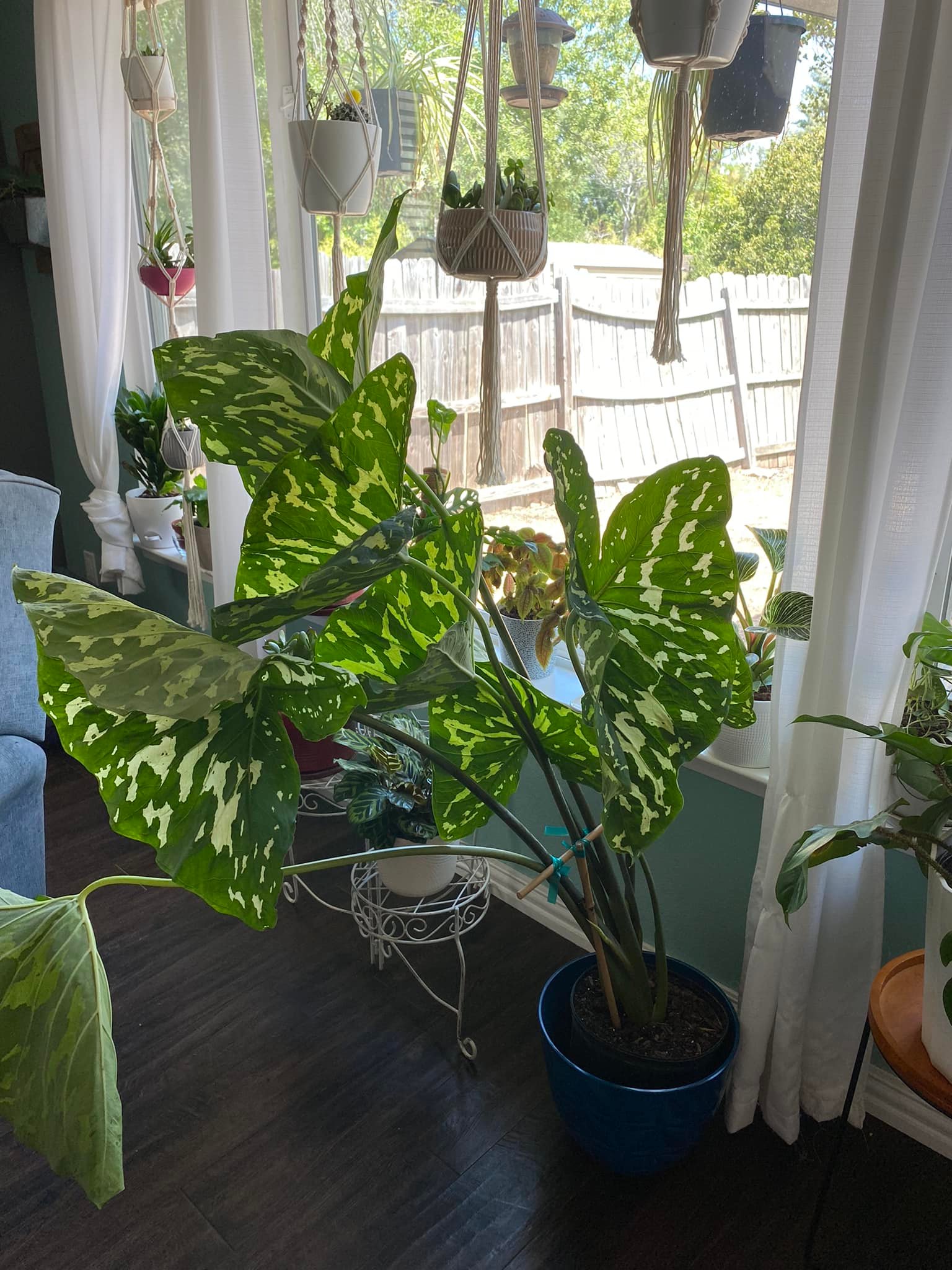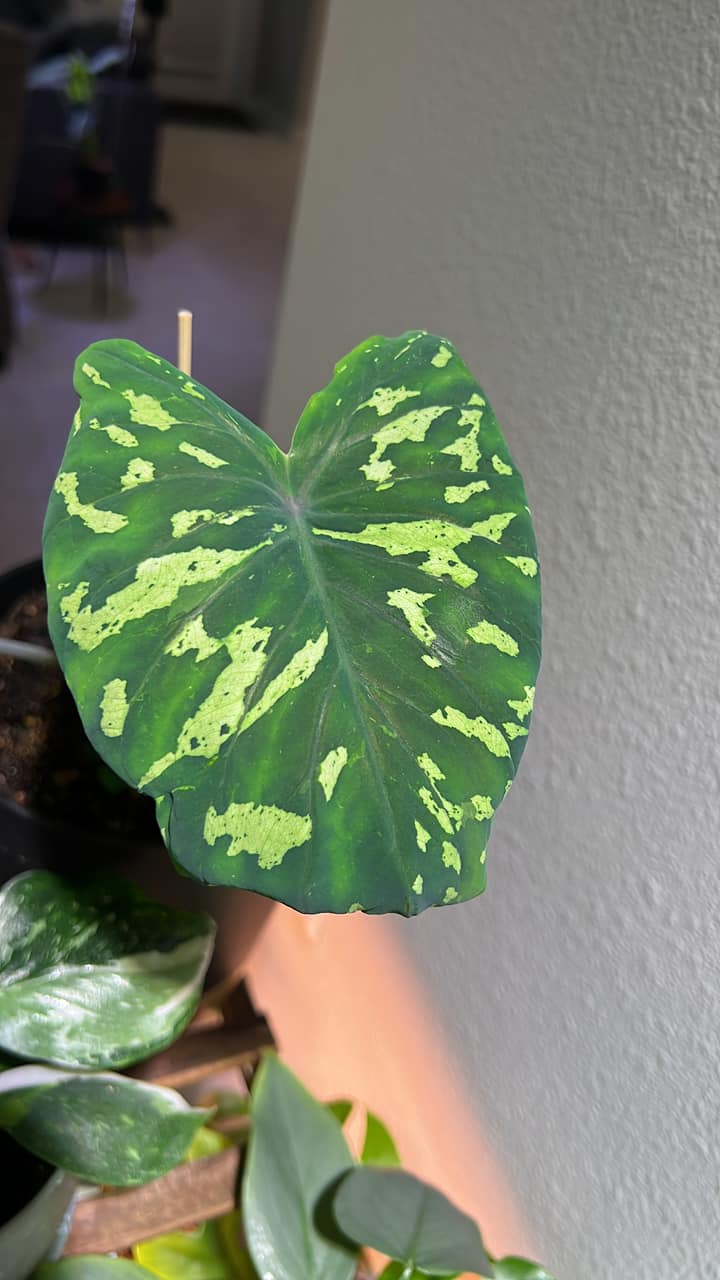
Imagine stepping into your living room and being greeted by a lush, vibrant splash of green — giant leaves shimmering like polished marble, each one a unique canvas of color. This isn’t a rainforest dream; it’s the magic of Alocasia Hilo Beauty.
Known for its spectacular foliage, Alocasia Hilo Beauty has earned its place as a showstopper among houseplants. But to keep this jungle gem thriving, you’ll need to understand its needs and quirks.
Ready to transform your home into a tropical paradise? Let’s unlock the secrets of Alocasia Hilo Beauty care so you can grow a truly stunning indoor masterpiece!
The Allure of Alocasia Hilo Beauty

Why Does Alocasia Hilo Beauty Steal Hearts?
Alocasia Hilo Beauty is not your average houseplant. Its dramatic presence makes it an instant focal point wherever it lives. But what makes it so captivating?
- Striking foliage: The leaves are large, arrow- or heart-shaped, with a mesmerizing marbled pattern of creamy white, lime, and dark green. Each leaf looks hand-painted.
- Exotic presence: This plant brings the essence of tropical jungles right into modern homes, creating a mini rainforest vibe.
- Unique collector’s item: It’s not as commonly found as other Alocasias, which makes it a prized addition for plant enthusiasts.
- Versatile decor piece: Whether placed in minimalist interiors or boho jungles, its architectural leaves make a bold statement.
People fall in love with Alocasia Hilo Beauty because it’s both wild and elegant. However, this beauty comes with a reputation for being a bit demanding — a true diva that expects to be pampered.
Understanding Your Jungle Gem
Where Does Alocasia Hilo Beauty Come From?
Alocasia plants are native to the humid rainforests of Southeast Asia. They thrive in filtered light beneath towering trees, absorbing moisture from the humid air and rich forest soil.
Though the Hilo Beauty itself is a cultivated hybrid rather than a naturally occurring species, it carries the same tropical DNA:
- Warm temperatures.
- High humidity.
- Indirect light.
Understanding this tropical background is crucial. When you know where your Alocasia comes from, you’re better equipped to recreate similar conditions at home.
Perfect Lighting for Alocasia Hilo Beauty
How Much Sunlight Does It Need?
Lighting is arguably the most important factor for keeping Alocasia Hilo Beauty thriving. It adores bright light but wants it softened — think dappled jungle light, not blazing desert sun.
Best lighting options:
- Place it near east- or north-facing windows, where the sunlight is gentle.
- Use sheer curtains to diffuse harsh light in south- or west-facing rooms.
- Consider LED grow lights for consistent brightness if your home is naturally dim.
Why avoid direct sunlight?
- Direct rays can burn and bleach the delicate variegation on the leaves.
- Overexposure may lead to crispy edges and scorched spots.
If your plant’s leaves are growing smaller, turning pale, or leaning dramatically toward the window, it’s asking for more light. On the flip side, if you see burns or faded patches, the light is too intense.
Ask yourself: Does my Alocasia have enough jungle vibes — or is it sunbathing too hard?
Watering Your Alocasia: Striking the Right Balance
How Often Should You Water?
One of the trickiest aspects of caring for Alocasia Hilo Beauty is watering. Too much water, and you risk root rot. Too little, and the plant droops in protest.
Here’s how to find the sweet spot:
- Water only when the top 1-2 inches of soil feel dry to the touch.
- Always test soil moisture with your finger before watering.
- Pour water evenly around the pot until it drains from the bottom.
- Empty excess water from the saucer to avoid soggy roots.
Signs of overwatering:
- Yellowing leaves that fall off.
- Soft, mushy stems.
- Musty or sour smell from the soil.
Signs of underwatering:
- Dramatic drooping of leaves.
- Leaf edges turning crisp and brown.
- Slow growth or stunted new leaves.
Remember: Alocasia prefers consistent, light moisture rather than extremes of drought and flooding. Think rainforest mist, not monsoon downpour.
Humidity: A Tropical Essential
Does Alocasia Hilo Beauty Need High Humidity?
Absolutely! For Alocasia Hilo Beauty, humidity isn’t just a comfort — it’s a necessity.
- Ideal humidity: 60% to 80%.
- Anything below 50% may result in browning leaf tips.
Ways to increase humidity:
- Place a humidifier near your plant.
- Group your Alocasia with other tropical plants to create a microclimate.
- Use a pebble tray: Place pebbles in a shallow tray, fill it with water, and set the pot on top. As water evaporates, it humidifies the air.
- Mist the leaves lightly, though misting alone often isn’t enough for sustained humidity.
If your Alocasia develops crispy tips or looks dull, it’s crying out for more moisture in the air.
Ask yourself: Could I breathe easily in the same air my Alocasia breathes? If the answer is no, it’s time to crank up the humidity!
Temperature Requirements
What Temperature Does Alocasia Prefer?
Alocasia Hilo Beauty thrives in warm conditions reminiscent of a tropical rainforest floor. Think gentle warmth, not scorching heat.
- Optimal temperature range: 65°F to 80°F (18°C to 27°C).
- Avoid exposure below 60°F (16°C).
- Keep away from cold drafts, heaters, and air conditioning vents.
Sudden temperature drops can shock the plant, causing leaves to droop or yellow. Consistency is key.
A great rule of thumb: If you’re comfortable in a t-shirt indoors, your Alocasia probably is too.
Choosing the Right Soil Mix
What Type of Soil is Best?
Alocasia Hilo Beauty demands excellent drainage while maintaining enough moisture for its roots. The perfect soil mix is airy yet moisture-retentive.
Ideal soil components:
- Potting soil for nutrients and structure.
- Orchid bark or coarse perlite for airflow.
- Coco coir or peat moss for moisture retention.
- Horticultural charcoal to help with drainage and odor control.
Sample mix:
- 40% potting soil
- 30% orchid bark or chunky perlite
- 20% coco coir or peat moss
- 10% horticultural charcoal
This mix ensures roots stay oxygenated and reduces the risk of rot.
Feeding Your Alocasia Hilo Beauty
Does It Need Fertilizer?
Yes — Alocasia Hilo Beauty is a hungry plant during its growing season.
- Fertilize every 4 weeks during spring and summer.
- Use a balanced liquid fertilizer (20-20-20) diluted to half-strength.
- Alternatively, sprinkle a slow-release granular fertilizer into the soil at the start of spring.
Avoid fertilizing in winter when the plant’s growth slows. Excess fertilizer during dormancy can burn the roots.
Remember: It’s always better to under-fertilize slightly than overdo it.
Repotting Alocasia Hilo Beauty
How Often Should You Repot?
Repotting helps Alocasia stay healthy by giving roots space and fresh soil nutrients.
- Repot every 12-24 months or when roots outgrow the pot.
- Choose a pot only 1-2 inches larger in diameter.
- Refresh the soil completely when repotting.
Steps to repot:
- Gently remove the plant from its pot.
- Loosen soil around the roots.
- Check for any rotting roots and trim if needed.
- Replant into fresh soil in the new pot.
- Water lightly and place in indirect light.
Tip: Wear gloves while handling Alocasia to avoid irritation from its sap.
Pruning and Grooming
Should You Prune Alocasia Hilo Beauty?
Though not a plant that requires heavy pruning, Alocasia Hilo Beauty benefits from some grooming:
- Remove yellowing or damaged leaves by cutting them at the base.
- Wipe leaves weekly with a soft, damp cloth to remove dust.
- Inspect for pests during your cleaning routine.
Clean leaves not only look better but help the plant photosynthesize more efficiently.
Dealing with Common Pests
What Pests Target Alocasia Hilo Beauty?
Even the most pampered Alocasia can fall victim to pests. The most common include:
- Spider mites: Tiny red or yellow insects producing fine webs under leaves.
- Aphids: Small, soft-bodied insects clustered along stems.
- Mealybugs: White, cottony clumps at leaf joints.
- Thrips: Slender insects causing silvery streaks on leaves.
Treatment:
- Isolate the affected plant.
- Wipe leaves with soapy water.
- Apply neem oil or insecticidal soap.
- Repeat treatment every few days until pests are gone.
Early detection saves your plant from significant damage.
Winter Care Tips
How Does Alocasia Hilo Beauty Fare in Winter?
Winter is a test of your plant-parenting skills:
- Growth slows significantly due to reduced light.
- Water less often to avoid soggy soil.
- Keep humidity levels high.
- Avoid drafts and temperature fluctuations.
Expect some leaf loss in winter — it’s normal for Alocasia to shed a few leaves during dormancy.
Alocasia Hilo Beauty Toxicity
Is Alocasia Safe for Pets and Kids?
Alocasia Hilo Beauty is toxic if ingested due to calcium oxalate crystals. This can cause:
- Burning or swelling in the mouth and throat.
- Excessive drooling in pets.
- Vomiting.
Keep it out of reach of children and curious pets. If accidental ingestion occurs, seek medical attention immediately.
Alocasia Hilo Beauty Troubleshooting Guide
Here’s a quick-reference guide for your plant’s SOS signals:
| Problem | Likely Cause | Solution |
|---|---|---|
| Yellow leaves | Overwatering or cold temps | Let soil dry out, keep warm |
| Brown tips | Low humidity, underwatering | Increase humidity, water regularly |
| Drooping leaves | Temperature shock, dry soil | Stabilize environment, water properly |
| Pale leaves | Insufficient light | Move to brighter spot |
| Root rot | Waterlogged soil | Repot in fresh, well-draining mix |
Why Grow Alocasia Hilo Beauty?
What Makes It Worth the Effort?
While Alocasia Hilo Beauty is a bit more demanding than some houseplants, the payoff is breathtaking. Few plants bring such dramatic flair and tropical energy into your home.
- It’s a living piece of art.
- It transforms your space into a tropical oasis.
- It’s a unique collector’s item.
If you’re up for the challenge, growing this plant is incredibly rewarding.
